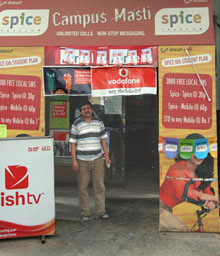Nokia Bets on Mobile Payment
A $70 million investment by Nokia in a mobile-phone-payment system called Obopay suggests that, even in a plunging global economy, mobile financial services are guaranteed to grow in many of the world’s poorest nations.

In these parts of the world, many people lack access to traditional bank accounts and other financial services, but own mobile phones. Leveraging those phones as a way for people to access bank accounts, pay bills, borrow money, and pay loans is “a market that is exploding,” says Carol Realini, Obopay’s CEO. Realini believes that mobile-phone technology will affect financial services in a number of ways. “It will allow transactions in checks and cash to be done electronically,” she says. “That is the source of the opportunity that is unfolding around the world.”
Neither Obopay nor Nokia–the world’s largest maker of cell phones–would comment on what sort of program would unfold from the investment, which was announced last week and represents roughly a doubling of Obopay’s funding to date.
But Realini hinted at a huge scale-up in the global availability of mobile-payment services, especially given that about 1.3 billion Nokia phones are in circulation. “It really is about serving the globe,” she says. “[Nokia] makes around 1.2 million phones every day–we can add our capabilities to their distribution.” A Nokia spokesperson says that the company could not comment on the investment because it is in a quiet period ahead of an earnings announcement.
Multimedia
View charts showing cell-phone and banking trends in the developing world.
Obopay, based in Redwood City, CA, operates in the United States and India and is one of a handful of services that lets people transfer money to one another between bank accounts using a cell-phone software application or a text message. (Users can also do so via the Web, mobile or otherwise.) In the United States, Obopay charges a fee to users sending money (25 cents to send any amount up to $1,000). In India, fees for banking services are paid by banks, which have willingly done so because the service allows them to cultivate new account holders without having to build new retail branches. Obopay does not disclose its total number of customers in either country.
Like other mobile-payment companies, Obopay is mindful that the world has four million mobile-phone users–and most of them are poor, use prepaid plans, and lack bank accounts. “We have a model that serves the one billion with bank accounts, and a model that serves the three billion without, and we give the same level of service to both and allow them to participate in the same payment network,” Realini says.
India is an epicenter of this trend. More than 450 million Indians live below the poverty line, but more than 300 million Indians have cell phones. Some estimates suggest that India will have nearly 750 million cell-phone owners–the bulk of the newcomers from rural areas where banks are sparse–by late 2012. In terms of cross-border remittances, the United States is the leading source and India the leading recipient of such funds.
Another mobile service, mChek, based in Bangalore, says it now has one million users, mostly in India, who use the service to do things such as pay their cell-phone bills. “Nokia’s investment is a validation of the coming of age of mobile payments and the expectation that this is now likely to become mainstream in the near term,” says mChek’s CEO, Sanjay Swamy.
Both Obopay and mChek are also expanding into so-called microloans, in which users are able to open bank accounts with tiny amounts and then execute payments to suppliers or customers with simple cell-phone clicks. Though a Nokia spokesperson declined to comment, in a written statement last week, Teppo Paavola, Nokia’s head of corporate business development, said, “This investment reflects our belief in the global potential for mobile payments.”
Keep Reading
Most Popular
Large language models can do jaw-dropping things. But nobody knows exactly why.
And that's a problem. Figuring it out is one of the biggest scientific puzzles of our time and a crucial step towards controlling more powerful future models.
How scientists traced a mysterious covid case back to six toilets
When wastewater surveillance turns into a hunt for a single infected individual, the ethics get tricky.
The problem with plug-in hybrids? Their drivers.
Plug-in hybrids are often sold as a transition to EVs, but new data from Europe shows we’re still underestimating the emissions they produce.
Stay connected
Get the latest updates from
MIT Technology Review
Discover special offers, top stories, upcoming events, and more.